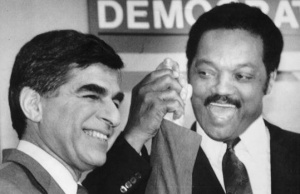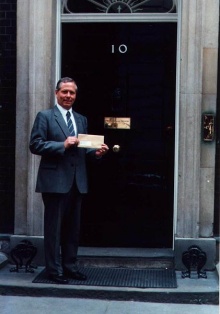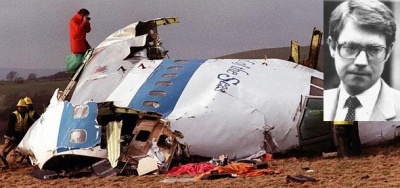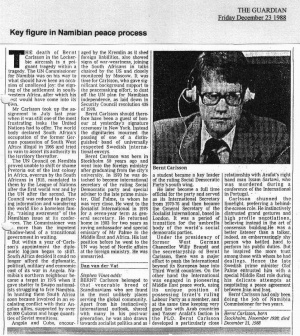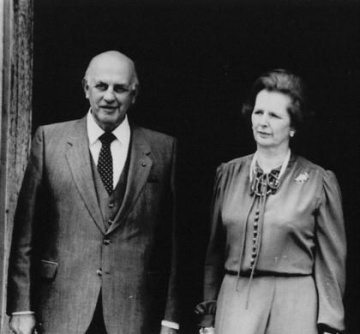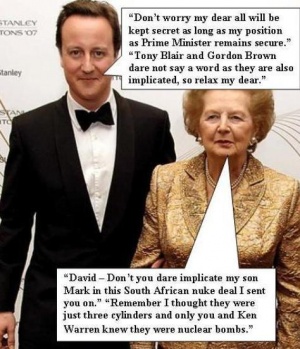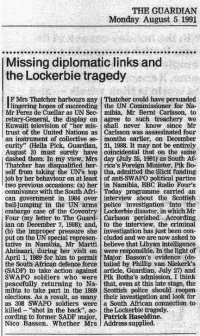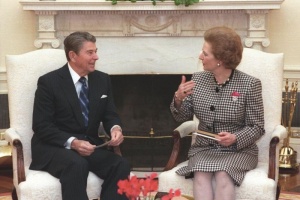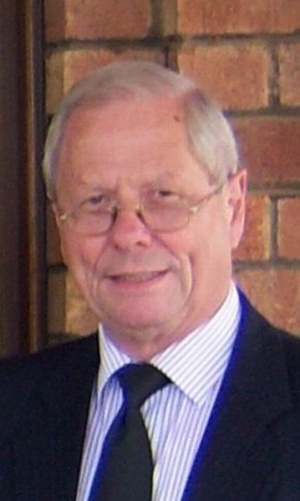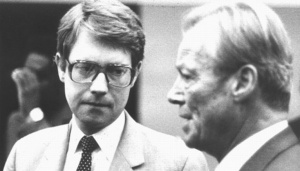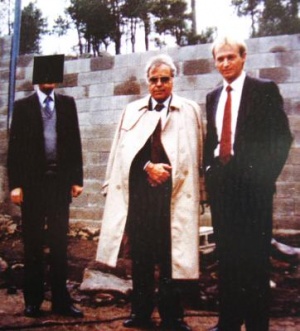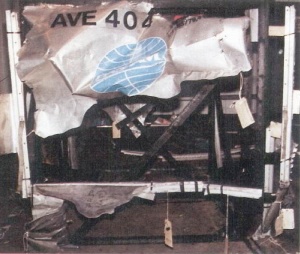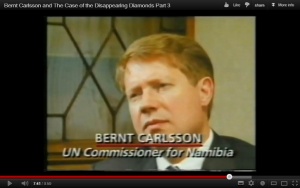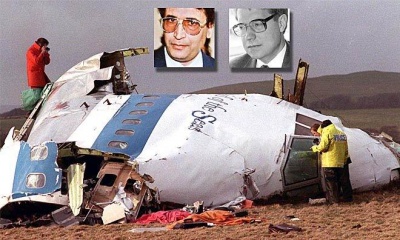Bernt Carlsson
(Diplomat) | |||||||||||||||||||||||||||||||||||||||||||||||||||||||||||||
|---|---|---|---|---|---|---|---|---|---|---|---|---|---|---|---|---|---|---|---|---|---|---|---|---|---|---|---|---|---|---|---|---|---|---|---|---|---|---|---|---|---|---|---|---|---|---|---|---|---|---|---|---|---|---|---|---|---|---|---|---|---|
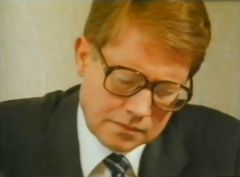 | |||||||||||||||||||||||||||||||||||||||||||||||||||||||||||||
| Born | Bernt Wilmar Carlsson 21 November 1938 Stockholm, Sweden | ||||||||||||||||||||||||||||||||||||||||||||||||||||||||||||
| Died | 21 December 1988 (Age 50) | ||||||||||||||||||||||||||||||||||||||||||||||||||||||||||||
| Alma mater | University of Stockholm | ||||||||||||||||||||||||||||||||||||||||||||||||||||||||||||
| Interest of | Laurie Flynn, Patrick Haseldine | ||||||||||||||||||||||||||||||||||||||||||||||||||||||||||||
| |||||||||||||||||||||||||||||||||||||||||||||||||||||||||||||
| This page has been nominated for splitting up. This page is overlong. Use the discussion page to see the debate about this. |
Bernt Carlsson was Assistant Secretary-General of the United Nations and UN Commissioner for Namibia from July 1987 until he died on Pan Am Flight 103 which exploded on 21 December 1988 over Lockerbie, Scotland. Bernt Carlsson was on his way to New York to attend the signing ceremony on 22 December 1988 at United Nations headquarters of the New York Accords granting independence to Namibia, which had been illegally occupied by apartheid South Africa in defiance of UN Security Council Resolution 435.
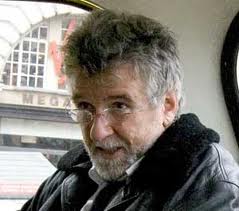
Following the UN Commissioner's death at Lockerbie, South African foreign minister Pik Botha went ahead and signed the Tripartite Accord. However, instead of handing control of Namibia to the United Nations, Pik Botha put the apartheid regime's Administrator-General, Louis Pienaar, in charge.
No investigation by the Scottish Police, the CIA, the FBI or the United Nations has ever been conducted into the evident targeting of Bernt Carlsson on Pan Am Flight 103, despite the branding of apartheid South Africa as a "terrorist state" by Michael Dukakis, the Democratic nominee in the 1988 US presidential election campaign.[1]
On 30 April 2015, at lunch with Lockerbie campaigner Patrick Haseldine, journalist and filmmaker Laurie Flynn recounted how he had arranged for UN Commissioner for Namibia Bernt Carlsson to travel from New York to Manchester for Granada TV's 1987 World In Action documentary "The Case of the Disappearing Diamonds":
- "Bernt insisted that we should visit several pubs in Manchester to sample the beer, which made for a very relaxed interview."
Haseldine was impressed with the Bernt Carlsson interview but told Flynn he was puzzled why there has been no inquiry into Bernt Carlsson's murder in the 1988 Lockerbie bombing:
- "The responsibility for investigating Bernt Carlsson's murder clearly rests with the Metropolitan Police since the bomb that brought down Pan Am Flight 103 was loaded at Heathrow.
Contents
- 1 Highest profile Lockerbie bombing victim
- 2 Lockerbie cover-up
- 3 Social democrat
- 4 Socialist International
- 5 Swedish diplomat
- 6 UN Commissioner for Namibia
- 7 Assassinated on Pan Am Flight 103
- 8 Diplomatic faux pas by fiancée
- 9 Calls for an Inquiry
- 10 Memorials
- 11 See also
- 12 External links
- 13 Related Documents
- 14 References
Highest profile Lockerbie bombing victim
Newspaper reports quickly identified Assistant Secretary-General of the United Nations and UN Commissioner for Namibia, Bernt Carlsson, as the highest profile Lockerbie bombing victim.
The New York Times
The New York Times of Thursday, 22 December 1988 reported:
- U.N. Officer on Flight 103
- "Bernt Carlsson, who was a passenger on the Pan Am flight that crashed over Scotland, had been chief administrative officer of the United Nations Council for Namibia since July 1987. He was on his way here for a ceremony on Thursday, at which accords providing for Namibia's independence are to be signed by Angola, Cuba and South Africa. The officer is, in theory, the United Nations' appointed governor for Namibia, the South African-ruled territory also known as South-West Africa. But because United Nations authority over Namibia is not recognised by South Africa, he is in practice the chief United Nations officer in charge of development programs intended to prepare Namibia for independence.
- "Mr Carlsson, a 51-year-old Swedish diplomat, had been in London for a meeting with non-governmental groups, United Nations officials said. He telephoned his office from the boarding gate at Heathrow Airport before the flight to New York.
- "From 1983 to 1985 Mr Carlsson served as a Swedish Ambassador at Large to the Middle East. He was General Secretary of the Socialist International, the world federation of socialist and social democratic parties, from 1976 to 1983. From 1983 to 1985, he was an Ambassador at Large and special emissary of Prime Minister Olof Palme to the Middle East and Africa. He was also international secretary of the Swedish Social Democratic Party and as Under Secretary of State for Nordic Affairs in the Swedish Foreign Ministry."[3]
The Guardian
Bernt Carlsson's Obituary appeared in The Guardian of 23 December 1988:[4]
- "Key figure in Namibian peace process"
- "The death of Bernt Carlsson in the Lockerbie aircrash is a poignant tragedy within a tragedy. The UN Commissioner for Namibia was on his way to what should have been an occasion of unalloyed joy: the signing of the settlement in south-western Africa, after which his post would have come into its own.
- "Mr Carlsson took up the assignment in July last year when it was still one of the most frustrating tasks the United Nations had to offer. The world body declared South Africa’s occupation of the former German possession of South West Africa illegal in 1966 and tried in vain to assert its authority in the territory thereafter.
- "The UN Council for Namibia proved unable to shift or shame Pretoria out of the last colony in Africa, overrun by the South Africans in 1915, mandated to them by the League of Nations after the first world war and by the UN after the second. The Council was reduced to gathering information and wandering the world like a homeless family, "raising awareness" of the Namibian issue at its conferences. The Commissioner was no more than the impotent shadow-head of a transitional government in waiting.
- "But within a year of Carlsson’s appointment the diplomatic log-jam began to shift. South Africa decided it could no longer afford the diplomatic, political, military and economic cost of its war in Angola. Namibia’s northern neighbour became a target in 1975 when it gave shelter to SWAPO nationalists struggling to free Namibia. In hunting them South Africa soon became involved in an escalating conflict with their Angolan allies, supported by over 50,000 Cubans and huge quantities of Soviet munitions.
- "Angola and Cuba, encouraged by the Kremlin as it shed foreign liabilities, also showed signs of war-weariness, joining the South Africans in talks chaired by the US and closely monitored by Moscow. It was time for Carlsson, who gave significant background support to the peacemaking effort, to dust off the UN plan for Namibian independence, as laid down in United Nations Security Council Resolution 435 of 1978.[5]
- "Bernt Carlsson should therefore have been a guest of honour at yesterday’s signature ceremony in New York. Instead the dignitaries mourned the passing of one of a distinguished band of universally respected Swedish international envoys.
- "Bernt Carlsson was born in Stockholm 50 years ago and went into the foreign ministry after graduating from the city’s university. In 1970 he was detached to become international secretary of the ruling Social Democratic party and special adviser to the late prime minister, Olof Palme, to whom he was very close. He went to the Socialist International in 1976 for a seven-year term as general secretary. He returned home in 1983 for two years as roving ambassador and special emissary of Mr Palme to the Middle East and Africa. His last position before he went to the UN was head of Nordic affairs at the foreign ministry. He was unmarried." (by Dan van der Vat)
Los Angeles Times
An Obituary to Bernt Carlsson, written by his friend Michael Harrington, was published in the Los Angeles Times on 26 December 1988.[6]
- "Lost On Flight 103: A Hero To The Wretched Of The World"
- "It was not an accident that my friend Bernt Carlsson, the UN Commissioner for Namibia, was killed in the crash of Pan American World Airways Flight 103.
- "Of course, it was a cruel and capricious fate that struck at Carlsson and his fellow passengers. But in Bernt's case it was part of a pattern - the kind of thing that might happen to a man who had spent his life ranging the Earth in search of justice and peace. And that life itself was emblematic of a Swedish socialist movement that has made solidarity with the wretched of the world a personal ethic.
- "Carlsson was returning home to New York for the signing of the agreement on Namibian independence, the culmination of his most recent mission. Before that he was a roving ambassador. From 1976 to 1983 he had been the general secretary of the Socialist International when that organisation was reaching out to the Third World as never before.
- "There had been so many flights, so many trips to the dangerous places like the Middle East and the front-line states of Southern Africa - even a brush with "terrorism" when Issam Sartawi, a Palestinian moderate, was murdered in the lobby of the Portuguese hotel at which the International was holding its congress in 1983. It was not inevitable that Carlsson be on a plane that, some suspect, was the target of fanatics, but it was not surprising - not the least because he came from a movement that made peace-making a way of life.
- "I sometimes think that if these Swedish men and women did not exist, the world would have to invent them. So it was that the United Nations gave Carlsson's mentor, the late Olof Palme, the impossible task of negotiating an end to the Iran-Iraq War. And why, as I saw firsthand at a meeting in Botswana, the Swedish prime minister was deeply mourned in black Africa. I had joked with Palme after a visit to Dar-es-Salaam in 1976 that the typical Tanzanian must be blond-haired and blue-eyed because of all the Swedes I encountered in that city.
- "It was Carlsson's friend and contemporary, Pierre Schori, who had played a major role in setting up the catalytic meeting in Stockholm between Yasser Arafat and five American Jews. I saw Swedish Prime Minister Ingvar Carlsson in Paris on the day before that event, and he clearly regarded it as a serious governmental priority. Because the Swedish socialist commitment to peace-making sometimes requires criticism of the United States, there were those who said that its activists were "anti-American." When Palme was assassinated, practically every obituary remembered that he had marched with the North Vietnamese ambassador in a famous Stockholm rally against the American war; only one mentioned that, around the same time, the Swedish leader had publicly demonstrated in solidarity with the dissident communists of Czechoslovakia and against the Soviet invasion of their country.
- "Bernt Carlsson, like Palme and his other comrades, opposed Washington's policies and yet he deeply admired Americans, particularly their egalitarian irreverence. I remember vividly when Carlsson and I were in Managua in 1981 on a Socialist International mission to defend the revolution against Washington's intervention. Our group was led by Spanish Prime Minister Felipe Gonzalez and former Venezuelan President Carlos Andres Perez, which guaranteed that it was taken with the utmost seriousness by the Sandinistas.
- "Carlsson was utterly firm in his opposition to American destabilisation. But then, to underline his commitment to democracy, he went to the offices of the opposition newspaper, La Prensa, and took out a subscription.
- "This gentle, shy, soft-spoken man with a soul as tough as steel was the true son of a movement that has proved that the conscience of a small nation can affect the superpowers.
- "In Jewish legend, a handful of the just keep the world from being destroyed. One of them died on Pan Am Flight 103, and many of them, like the blond-haired, blue-eyed people I saw in Dar-es-Salaam, seem to be Swedish."
"Finger of suspicion"
Former British diplomat Patrick Haseldine first suspected the involvement of the apartheid regime in the Lockerbie bombing when he heard South African foreign minister Pik Botha's interview with the BBC Radio 4 Today Programme on January 11, 1989.
On that day Botha – along with other international representatives including UN Secretary-General Javier Pérez de Cuéllar – was in Stockholm to attend the memorial service for Bernt Carlsson, UN Commissioner for Namibia. Botha told the BBC that he had been forced to make a last-minute change in his own booking on Pan Am Flight 103 because of a warning by an intelligence source that he (Botha) was being targeted by Nelson Mandela and the African National Congress (ANC).
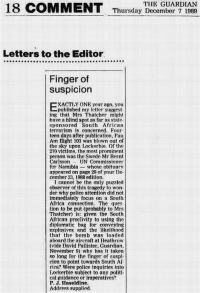
Using this information, which had not been reported elsewhere in the media, Haseldine wrote a letter to The Guardian on December 7, 1989:[7]
- "Finger of suspicion"
- "Exactly one year ago, you published my letter suggesting that Mrs Thatcher might have a blind spot as far as South African "terrorism" is concerned.
- "Fourteen days after publication, Pan Am Flight 103 was blown out of the sky upon Lockerbie. Of the 270 victims, the most prominent person was the Swede Mr Bernt Carlsson – UN Commissioner for Namibia – whose obituary appeared on page 29 of your December 23, 1988 edition.
- "I cannot be the only puzzled observer of this tragedy to wonder why police attention did not immediately focus on a South African connection. The question to be put (probably to Mrs Thatcher) is: given the South African proclivity to using the diplomatic bag for conveying explosives and the likelihood that the bomb was loaded aboard the aircraft at Heathrow (vide David Pallister, The Guardian, November 9, 1989) why has it taken so long for the finger of suspicion to point towards South Africa?
- "Were police inquiries into Lockerbie subject to any political guidance or imperatives?"
- P J Haseldine
- (Address supplied)
Carlsson's "secret meeting"
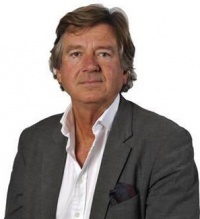
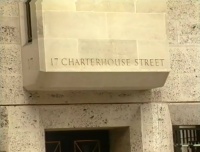
Jan-Olof Bengtsson is the political editor of Kvällsposten newspaper in Malmö, Sweden, and a renowned investigative journalist. Mr Bengtsson's most important work - although perhaps the least publicised - is his series of three articles in Sweden's iDAG newspaper on 12, 13 and 14 March 1990. Never published in the English language, the iDAG articles featured Sweden's UN Commissioner for Namibia Bernt Carlsson who was the most prominent victim of Pan Am Flight 103 which was sabotaged over Lockerbie, Scotland on 21 December 1988. Bengtsson alleged that Commissioner Carlsson's arm had been twisted by the diamond mining giant De Beers into making a stopover in London for a secret meeting and into joining the doomed flight, rather than taking as he had intended a Sabena flight direct from Brussels to New York:[8]
- "Bernt Carlsson, UN Commissioner for Namibia, had less than seven hours to live when at 11.06am on 21 December 1988 he arrived in London on flight BA 391.
- "Strictly speaking he was meant to fly directly from Brussels to New York in time for the historic signing of the Namibia Independence Agreement the day after. But Bernt Carlsson could not make it. He had a meeting. An important meeting with a 'pressuriser' from the South African diamond cartel, which was so secret that evidently not even Javier Pérez de Cuéllar, UN Secretary-General, knew anything about it. Here iDAG maps out the last 24 hours in the life of Bernt Carlsson.
- "The memorial service in the Folkets Hus in Stockholm on 11 January 1989 for Bernt Carlsson gathered most of our Heads of Government, representatives of the Namibia independence movement SWAPO and Javier Pérez de Cuéllar, the UN Secretary-General.
- "When he died in the Pan Am bombing, Bernt Carlsson was less than 24 hours away from the fulfilment of his dreams - the signing of the Namibia agreement in New York which would finally pave the way to a free and independent Namibia. This was supposed to be the climax of his career with the UN, a career that began in December 1986 when he was appointed Commissioner for Namibia. Bernt Carlsson had great support from SWAPO but much less so from South Africa because of that country's substantial economic interests in Namibia: an interest in gold, uranium but above all in diamonds.
- "Javier Pérez de Cuéllar in his speech at the memorial ceremony on a cold day in January last year [1989] described the last 24 hours in the life of Bernt Carlsson:
- 'Bernt Carlsson was returning to New York following an official visit to Brussels where he had spoken to a Committee within the European Parliament about the Namibia agreement,' Pérez de Cuéllar began. 'He stopped briefly in London to honour a long-standing invitation by a non-governmental organisation with interests in Namibia.'
- "Pérez de Cuéllar was wrong. True, Bernt Carlsson's trip to Brussels had been planned almost six months earlier. But his decision to return to New York via London was only made on 16 December 1988. The meeting in London was definitely not a long-standing invitation by Namibia sympathisers."
Namibian Sun
According to the Namibian Sun of 8 January 2014:
- The bombing of Pan Am Flight 103 over Lockerbie in Scotland on December 21, 1988 had helped to keep Namibia’s Rössing Uranium Mine in business, after a lead investigator into allegations of the illegal exportation of uranium from the then South-West Africa (SWA) perished in the deadly attack.
- Bernt Carlsson, the United Nations (UN) Assistant Secretary-General and Commissioner for Namibia at the time, was the highest-profile victim of that bombing, according to a report released this week.
- The report, compiled by former British diplomat Patrick Haseldine, suggests that Carlsson was the main target of the bombing - in order to end his high-profile investigation into allegations that there was a secret contract and operations arranged by British-based Rio Tinto Zinc Corp to import into Britain uranium (Yellowcake) from Rössing in Namibia.[9]
Lockerbie cover-up
Within a few weeks of those December 1988 newspaper reports, Bernt Carlsson's name would hardly ever be mentioned again by the commercially-controlled media in the Lockerbie context. Bernt Carlsson had effectively become a "nonperson" - whose death was never properly investigated - and the Lockerbie cover-up began in earnest:[10]
Nelson Mandela accused
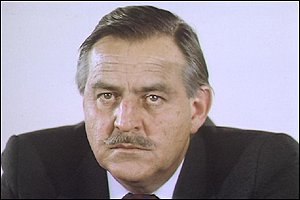
Three weeks after the Lockerbie disaster, the apartheid regime accused Nelson Mandela and the ANC of masterminding the sabotage of Pan Am Flight 103. This amazing accusation was made on 11 January 1989 by South African Foreign Minister Pik Botha who had travelled to Stockholm in Sweden with other foreign dignitaries – including UN Secretary-General Javier Pérez de Cuéllar – to attend the memorial service of UN Commissioner for Namibia, Bernt Carlsson, the highest profile victim of the 270 fatalities at Lockerbie.[11] Interviewed by Sue MacGregor on BBC Radio 4’s Today Programme, Pik Botha alleged that he and a 22-strong South African delegation, who were booked to fly from London to New York on 21 December 1988, had been targeted by the ANC. However, having been alerted to these ANC plans to kill him, Pik Botha said he managed to outsmart them by taking the earlier Pan Am Flight 101 from Heathrow to JFK, New York.[12] Pik Botha's claim to have been booked to travel on Pan Am Flight 103 was later shown to be false.[13]
President Botha quits
On 18 January 1989, President P W Botha was reported to have suffered a mild stroke which prevented him from attending a meeting with Namibian political leaders on 20 January 1989.[14] On 2 February 1989, P W Botha resigned as leader of the National Party (NP) anticipating his nominee – finance minister Barend du Plessis – would succeed him. Instead, the NP's parliamentary caucus selected as leader education minister F W de Klerk, who moved quickly to consolidate his position within the party. In March 1989, the NP elected de Klerk as state president but Botha refused to resign, saying in a television address that the constitution entitled him to remain in office until March 1990 and that he was even considering running for another five-year term. Following a series of acrimonious meetings in Cape Town, and five days after UN Security Council Resolution 435 was implemented in Namibia on 1 April 1989, Botha and de Klerk reached a compromise: Botha would retire after the parliamentary elections in September, allowing de Klerk to take over as president. However, P W Botha resigned from the state presidency abruptly on 14 August 1989 complaining that he had not been consulted by de Klerk over his scheduled visit to see president Kenneth Kaunda of Zambia: "The ANC is enjoying the protection of president Kaunda and is planning insurgency activities against South Africa from Lusaka," Botha declared on nationwide television. He said he had asked the cabinet what reason he should give the public for abruptly leaving office. "They replied I could use my health as an excuse. To this, I replied that I am not prepared to leave on a lie. It is evident to me that after all these years of my best efforts for the National Party and for the government of this country, as well as the security of our country, I am being ignored by ministers serving in my cabinet."[15]
Secret nuclear deal
Just over three months after the Lockerbie bombing, prime minister Margaret Thatcher made a point of visiting the Rössing Uranium Mine in Namibia as part of a tour to countries in Southern Africa.[16] On this visit to the Rössing Uranium Mine, she was accompanied by the rising star in the Conservative Research Department, David Cameron.[17] Mrs Thatcher was so impressed with the Rössing Uranium Mine that she declared it made her "proud to be British", a sentiment echoed by David Cameron.[18]
Although UN Security Council Resolution 418 of 4 November 1977 introduced a mandatory arms embargo against South Africa, requiring all states to refrain from "any co-operation with South Africa in the manufacture and development of nuclear weapons", it was with the help of the Israelis that the apartheid regime designed and built a total of 10 fully operational nuclear weapons. One device was successfully tested in 1979, which left 9 nuclear weapons in South Africa's stockpile.[19][20] In August 1988, foreign minister Pik Botha announced that South Africa had "the capability to make one [a nuclear weapon]" should it want to do so. A month later, in September 1988, South Africa sent a letter to IAEA Director-General Hans Blix expressing willingness to accede to the Nuclear Non-Proliferation Treaty (NPT) if certain conditions were met, primarily that South Africa be allowed to market its uranium subject to IAEA safeguards.[21]
In what has been described as a sanctions-busting trip, David Cameron visited South Africa in 1989 accompanied by Conservative MP, Sir Kenneth Warren, and nuclear weapons inspector, Dr David Kelly who had made several earlier visits to South Africa when he was given access to the covert nuclear weapons research facility at Pelindaba, near Pretoria.[22] The purpose of David Cameron's trip was to arrange for three of South Africa's nuclear weapons to be shipped to Oman, where the nukes would be stored in case they were required in Iraq. The remaining six nukes were destined to travel from South Africa to Chicago in the US. The next phase of the operation was that, once the weapons had left South African soil, the British Government would reimburse the South African firm Armscor and the British firm Astra through the middle man John Bredenkamp. At Government level it would be dealt with primarily by the Department of Trade and Industry (DTI) using Ministry of Defence money. In order to keep this out of Parliament and out of the public domain, Margaret Thatcher was asked to sign off these weapons in late 1990 under a special Urgent Operational Requirement (UOR) describing them as metal cylinders rather than nuclear bombs.[23]
It was subsequently revealed that £17.8 million was siphoned from this secret nuclear deal into Conservative Party funds.[24]
Pressure on UN's man
Extract from Patrick Haseldine's letter to The Guardian of August 5, 1991:
- Missing diplomatic links and the Lockerbie tragedy
- "On April 1, 1989 Mrs Thatcher put pressure on UN Special Representative in Namibia, Martti Ahtisaari, to permit the South African Defence Force (SADF) to take action against SWAPO soldiers who were peacefully returning to Namibia to vote in the 1989 independence elections. As a result, as many as 308 SWAPO soldiers were killed - shot in the back according to former SADF major Nico Basson.
- "Whether Mrs Thatcher could have persuaded UN Commissioner for Namibia, Bernt Carlsson, to agree to such treachery we shall never know since Mr Carlsson was assassinated four months earlier, on December 21, 1988.
- "It may not be entirely coincidental that on the same day (July 25, 1991) as South Africa's Foreign Minister, Pik Botha, admitted the illicit funding of anti-SWAPO political parties in Namibia, BBC Radio Four's Today Programme carried an interview about the Scottish police investigation into the Lockerbie disaster, in which Mr Carlsson perished. According to the interview, the criminal investigation has just been concluded and we are now asked to believe that Libyan intelligence were responsible.
- "In the light of Major Basson's evidence (detailed by Phillip van Niekerk's article, Guardian, July 27) and Pik Botha's admission, I think that, even at this late stage, the Scottish police should reopen their investigation and look for a South African connection to the Lockerbie tragedy.[25]
Stateside silence
Ronald Reagan, the outgoing President, was still smarting after having his veto overridden in 1986 by the US Congress of the Comprehensive Anti-Apartheid Act which, inter alia, banned South African Airways from flying to the United States. Plus, according to Professor Francis Boyle's recent book, President Reagan had some old scores that he wanted to settle with Muammar Gaddafi.[26]
So, on 28 December 1988, when there was as yet no evidence of any country's culpability for the Lockerbie bombing and in one of the last acts of his Presidency, Ronald Reagan extended US sanctions against Libya and threatened renewed bombing raids on Tripoli and Benghazi. Vice-President George H W Bush had won the 1988 US presidential election easily defeating Democratic Party challenger Michael Dukakis (who would have branded P W Botha's apartheid South Africa a 'terrorist state'[27]) and was sworn in as US President on 20 January 1989.
Drawing upon his previous experience at the United Nations and as Director of the CIA, and maintaining his refusal to apologise for the US Navy's destruction of the Iranian Airbus in July 1988, President Bush Sr then arranged for Muammar Gaddafi to be 'fitted up' at the UN Security Council for the sabotage of Pan Am Flight 103. According to British investigative journalist Paul Foot: "In mid-March 1989, three months after Lockerbie, George Bush rang Margaret Thatcher to warn her to 'cool it' on the subject."[28]
British Blackout
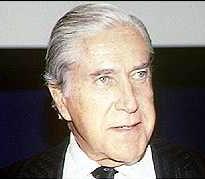
After years of sleuthing, Emeritus Professor of Lockerbie Studies Patrick Haseldine eventually identified British mining magnate, Observer newspaper owner and MI6 operative Tiny Rowland as the UK coordinator of the Lockerbie cover-up.[29]
Haseldine alleged that Tiny Rowland recruited Emeritus Professor of Scots Law Robert Black to organise the British Blackout and to frustrate all of Nelson Mandela’s plans for Lockerbie justice.[30]
So for the past 20 years, Professor Robert Black has been suppressing the truth about the Lockerbie disaster, thus delaying justice for the 270 victims of Pan Am Flight 103 and their relatives.
Prof Black was supported in his attempt to blackout apartheid South Africa’s targeting of Bernt Carlsson on Pan Am Flight 103 by inter alia these assets of British intelligence:
- John Ashton (Author, producer and researcher, see: The Maltese Double Cross[31]; the 2001 book "Cover-up of Convenience" by John Ashton and Ian Ferguson[32]; the 2012 book "Megrahi; You are my Jury" by John Ashton[33]; the 2012 article "Was Libya really behind it?" with John Ashton[34]; and a new book "Scotland’s Shame: Why Lockerbie Still Matters" which was published by Birlinn on 3 October 2013[35]);
- Ian Ferguson (Author, journalist and researcher, see: The Lockerbie Trial.com website of Prof Black and Ian Ferguson; and the 2009 film Lockerbie Revisited researcher Ian Ferguson[36][37]);
- Robert Forrester (Secretary of the Justice for Megrahi campaign group[38]);
- Professor Andrew Fulton (see: "Former MI6 spy joins Armor Group to hunt down new business"[39]);
- Dr Alan George (Middle East academic, recruited by solicitors Eversheds to reinforce the defence of Megrahi's co-accused Lamin Khalifah Fhimah[40]);
- Dr Morag Kerr (Deputy Secretary of the Justice for Megrahi campaign group, see [41], her book "Adequately Explained by Stupidity? Lockerbie, Luggage and Lies" was published in December 2013 [42]); and,
- Adam Larson (Associate of Dr Kerr and owner of The Lockerbie Divide website[43].)
Patrick Haseldine concludes: "It is high time that this 'Blackout over Lockerbie' was illuminated and dispelled."[44]
Social democrat
A native of Stockholm, Bernt Carlsson joined the Swedish Social Democratic Youth League when he was sixteen, studied economics at Stockholm University and, upon graduation, went into Sweden's foreign ministry. He worked as assistant to the Minister of Commerce in 1967 and, three years later, was assigned to be international secretary of the ruling Social Democratic Party of Sweden in 1970. Concurrent with his position in the party, Prime Minister, Olof Palme, appointed him as Special Adviser.
Socialist International
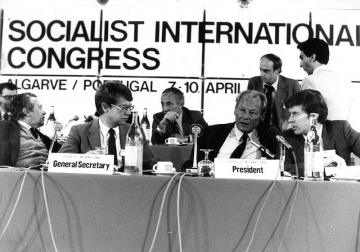
In 1976, Bernt Carlsson became Secretary-General of Socialist International (SI), based in London, at the same time as former Federal German Chancellor, Willy Brandt, assumed the SI presidency.
For the next seven years, Bernt Carlsson was engaged in extending the SI's influence beyond Europe to Third World countries, channelling money and political support to the struggle for liberation in Southern Africa. Carlsson also pioneered moves towards Middle East peace using the SI's unique position of having Israel's governing Labour Party as a member, and at the same time retaining very good ties with Arab countries and Yasser Arafat's faction in the Palestine Liberation Organisation (PLO).
Bernt Carlsson developed a particularly close relationship with Arafat's right-hand man, Issam Sartawi, whose murder during the SI congress in Portugal on 10 April 1983 Carlsson witnessed.
Bust-up with Brandt
Earlier in 1983, however, in a dispute about what he perceived as the SI president's authoritarian approach, Bernt Carlsson rebuked Willy Brandt saying:
"This is a Socialist International — not a German International."
Following the April 1983 SI congress in Albufeira, Portugal, to where Brandt had contentiously decided to relocate from Sydney — on account of the protests of newly-elected pro-Israeli Australian Prime Minister Bob Hawke against the PLO's inclusion — Brandt retaliated by forcing Bernt Carlsson to step down. Finland's Pentti Väänänen then took over as Secretary-General[45]
Burgled in London
In a 1989 tribute, Robin Sears, Canadian Deputy Secretary-General of Socialist International, wrote about the pressure put on Bernt Carlsson by apartheid South African "bastards":[46]
- "Others have paid more formal homage to his important political and diplomatic achievements. But as a fascinating and complex human being he was little known. These thoughts are an attempt to reveal some of the joys of knowing Bernt Carlsson.
- "We stood on the beach outside the Tel Aviv Hilton watching the teenagers at play, having just returned by helicopter from the devastated battle zones in Lebanon. More in wonder than in anger he said: 'How can they be so unaffected by the horrors. It's only a few minutes from here.'
- "The contradictions of political life didn't sit easily with him. Bernt had just come back from overseeing the despatch to burial in another country of his friend Issam Sartawi — assassinated the day before (10 April 1983) — ashen and grey with grief and anger. 'And they will never pay...', He muttered.
- "Sitting in the umpteenth airport departure lounge that month, Bernt whispered breathlessly about the break-in at the squalid little apartment in London he rarely saw. 'They messed things up and pawed through my papers. Then just to make sure I knew it wasn't a simple burglary they piled my money in the centre of the living-room rug.'
- "South African goons were active in London at the time, and some had a bizarre sense of humour. 'But don't talk about it, and I'm not going to report it. That would just give the bastards their little victory'."
Swedish diplomat
Bernt Carlsson left London and returned to Sweden in 1983 and, for two years, became Olof Palme's special emissary to the Middle East and Africa. Palme entrusted him with an important Middle East role in delicate attempts to negotiate a peace agreement between Iran and Iraq. From 1985 to 1987 Carlsson was head of Nordic Affairs in Sweden's foreign ministry. On 28 February 1986, Olof Palme was assassinated.
UN Commissioner for Namibia
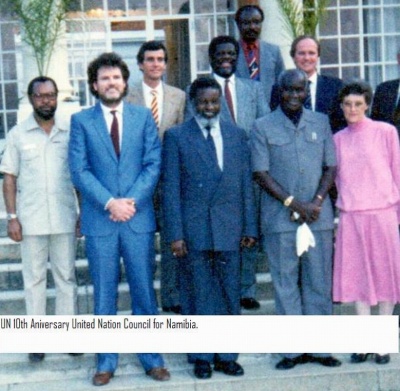
On July 1, 1987 Bernt Carlsson was appointed an Assistant-Secretary-General of the United Nations and the UN Commissioner for Namibia. A year later, he convened a meeting in Stockholm between the SWAPO leadership (Sam Nujoma, Hage Geingob and Hidipo Hamutenya), and a delegation of "whites" from Namibia to discuss developments in the independence process.
Namibia's independence had been expected to take place soon after United Nations Security Council Resolution 435 was agreed in September 1978. However, it took over 10 years for UNSCR 435 to be implemented. The delay was blamed by author and journalist Christopher Hitchens on Chester Crocker's 'procrastination' and on President Ronald Reagan's 'attempt to change the subject to the presence of Cuban forces in Angola' as well as the 'flagrant bias' in America's Namibia policy in favour of apartheid South Africa. Hitchens praised Carlsson's role as a 'neutral mediator' in the process leading to Namibia's independence:[47]
"An important participant was Bernt Carlsson, UN Commissioner for Namibia, who worked tirelessly for free elections in the colony and tried to isolate the racists diplomatically. Carlsson had been Secretary-General of the Socialist International, and International Secretary of the Swedish Social Democratic Party. He performed innumerable services for movements and individuals from Eastern Europe to Latin America. His death in the mass murder of the passengers on Pan American Flight 103 just before Christmas 1988, and just before the signing of the Namibia accords in New York, is appalling beyond words."
An editorial in The Guardian of December 23, 1988 stated:
"Two days before Christmas, two tides flow strongly. One - the greater tide - is the tide of peace. More nagging, bloody conflicts have been settled in 1988 than in any year since the end of the Second World War. There are forces for good abroad in the world as seldom before. There is also a tide of evil, a force of destruction. By just one of those ironies which afflict the human condition, peace came to Namibia yesterday. Meanwhile, on a Scottish hillside, the body of the Swedish UN Commissioner for Namibia was one amongst hundreds strewn across square miles of debris: a victim - supposition, but strongly based - of a random terrorist bomb which had blown a 747 to bits at 31,000 feet."[48]
Ten years were to elapse until the Ronald Reagan/Mikhail Gorbachev summit of the leaders of the United States and the Soviet Union in Moscow (May 29, 1988 – June 1, 1988), which led to the Brazzaville Protocol on 13 December 1988 and the New York Accords on 22 December 1988, and finally secured the implementation of UNSCR 435, requiring South Africa to relinquish its control of Namibia.[49]
Assassinated on Pan Am Flight 103
Of the 270 people murdered at Lockerbie on 21 December 1988, Assistant-Secretary-General of the United Nations and UN Commissioner for Namibia, Bernt Carlsson, was obviously a target. Yet the Lockerbie investigators (CIA, FBI and the Scottish Police) failed to undertake even the most cursory of investigations into Bernt Carlsson's murder. Commissioner Carlsson was to have taken charge of Namibia on 22 December 1988 immediately after apartheid South Africa had signed the New York Accords at UN headquarters giving up its illegal occupation of the country.[50]
Grey Presikhaaf suitcase
In evidence given at the Lockerbie trial on 15 June 2000, expert witness Alan Feraday identified at least 13 items said to be from the Brown Samsonite suitcase, which was alleged to have contained the bomb. Journalist Ian Ferguson was puzzled:
- Feraday pinpointed the location of the case down to the last centimetre, on the second layer of bags in container AVE4041. Immediately below where Feraday claims the bomb went off, investigators identified a Grey Presikhaaf suitcase (belonging to UN Commissioner for Namibia, Bernt Carlsson). In the early stages of the investigation, Bernt Carlsson's suitcase was seen as the more likely bomb case. Police sources at the time said that this case was cleared of being the suspect case on November 23rd 1989.
- To date not one item from the contents of Bernt Carlsson's Presikhaaf have been found. If there is a scientific reason why nothing has been found from this case, situated below the bomb case then it has not yet been explained in court. To a layperson it seems odd that the case adjacent to a bomb case should have no contents remaining, but from the bomb case itself we have an array of items. So what happened to the contents of Bernt Carlsson's Presikhaaf?[51]
Namibian Yellowcake
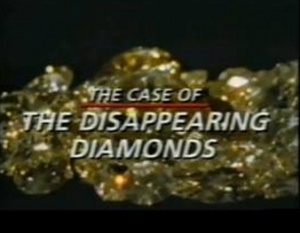
On 10 March 1980, the TV documentary "Follow the Yellowcake Road" was broadcast in the UK by Thames Television.[52] Synopsis of the film:
- "World In Action investigates the secret contract and operation arranged by British-based Rio Tinto Zinc Corp to import into Britain uranium (Yellowcake) from the Rössing Uranium Mine in Namibia, whose major shareholders are the governments of Iran and South Africa. This contract having received the blessing of the British government is now compromising the UK's position in the United Nations negotiations to remove apartheid South Africa from Namibia, which it is illegally occupying."[53]
In May 1985, the UN Council for Namibia decided to take legal action against the Dutch arm of the Anglo/Dutch/German consortium URENCO for breaching the UNCN Decree by importing uranium ore from the Rössing Uranium Mine in Namibia. The case was expected to be ready by the end of 1985 but was delayed because URENCO argued that, despite having enriched uranium of Namibian origin since 1980, it was impossible to tell where specific consignments came from. When the case finally reached court in July 1986, the Dutch government took URENCO's line, claiming not to have known where the uranium had been mined.[54]
Upon the adjournment of the URENCO proceedings, SWAPO's UN representative, Helmut Angula, insisted that other companies, such as Shell, De Beers (Consolidated Diamond Mines), Newmont, and Rio Tinto Group were also likely to face prosecution for breaching the UNCN Decree.[55]
Gem Diamonds
In a 28 September 1987 World In Action TV documentary ("The Case of the Disappearing Diamonds"), UNCN Bernt Carlsson warned that he intended to start proceedings against the countries and firms which had been defying UN law over many years by stealing billions of pounds' worth of Namibia's natural resources. Among those facing UN compensation claims were: the diamond mining firm De Beers; P W Botha's apartheid regime of South Africa; Rio Tinto Group, owners of the Rössing Uranium Mine; and, the government of Iran which today still owns 15% of Rössing and, in 1988-89, received large shipments of uranium from Namibia. When asked if he would be taking action against other companies such as De Beers, the diamond mining conglomerate, Bernt Carlsson told interviewer John Coates:
- "All the companies which are carrying out activities in Namibia which have not been authorised by the United Nations are being studied at present. As far as De Beers is concerned, the corporation has been trying to skim the cream which means they have gone for the large diamonds at the expense of the steady pace. In this way they have really shortened the lifespan of the mines. One would expect from a worldwide corporation like De Beers and Anglo American that they would behave with an element of social and political responsibility. But their behaviour in the specific case of Namibia has been one of profit maximation regardless of its social, economic, political and even legal responsibility."[56]
Because Bernt Carlsson was murdered on Pan Am Flight 103 at Lockerbie on 21 December 1988, none of those prosecutions ever took place. [57]
Flight 103: It was the Uranium
On 6 January 2014, The Ecologist magazine published an article entitled "Flight 103: It was the Uranium", which began:
- Mystery continues to surround the 1988 downing of Pan Am Flight 103 at Lockerbie - who did it, how, and why? After 25 years study of the topic Patrick Haseldine reveals the shocking truth.
- A little over two weeks ago, my wife and I were seated beside the flower bedecked pulpit in a packed Westminster Abbey.
- There was an eerie hush as Big Ben's muffled chimes tolled 7:00 pm - the exact moment 25 years earlier when Pan Am Flight 103 was sabotaged over Lockerbie in Scotland on 21st December 1988.
- All 259 passengers and crew were killed, as were 11 people in the town. The names of the 270 Lockerbie bombing victims were listed alphabetically in the Order of Service, and five relatives took it in turns to read them out.
- Thus it was Jane Swire, mother of victim Flora and wife of Dr Jim Swire, who read the name of the 43rd victim on the list: Bernt Wilmar Carlsson.
- United Nations Assistant Secretary-General and Commissioner for Namibia, Bernt Carlsson, was Lockerbie's highest profile victim, yet the authorities and the media never mention him. Why?[58]
Diplomatic faux pas by fiancée

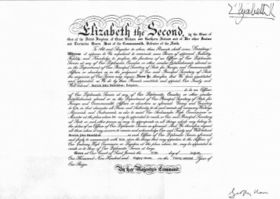
On 24 December 2000, towards the end of the Lockerbie trial, Safia Aoude posted the following item on her Pan Am 103/Lockerbie website:
- "Former British diplomat accuses South Africa of Lockerbie bombing"
- The former British diplomat Patrick Haseldine was sacked by HM Government in 1988 accused of abusing his freedom of speech. Since then he has tried to convince the world that South Africa was behind the bombing of Pan Am Flight 103. He has recently posted a number of messages on the Lockerbie Trial Discussion Board. He has also tried to post a number of documents and letters in the British press, allegedly containing circumstantial evidence of South Africa´s involvment into the Lockerbie bombing. Since 1993 no media has printed any of his documents.
- But now readers/viewers of this website can have a look of their own into the accusations of Mr Haseldine, starting with a concise introduction of what he thinks went wrong on Pan Am 103 - and why:[59]
- Meanwhile, relatives of the victims on Pan Am 103 are enraged over Haseldine´s claims. Sanya Popovic from the American victims' organisation Victims of Pan Am Flight 103, Inc said:
- "Not only is Haseldine quite out to lunch on this issue, but his (anniversary related) surfacings have caused real pain to me, my family, Bernt's sister and the rest of Bernt Carlsson's extended family. The Haseldine file, if it is what he has sent me previously, is a rehash of secondary sources, which he has culled from the Internet. He has no personal knowledge whatsoever about this very tragic matter."
- "Haseldine was not ever even a diplomat, insofar as information officer does not quite bequeath the same aura of legitimacy as true "diplomat" does, which he claims to be, but never was," said Ms Popovic.[60]
As evidence that he had in fact been a member of HM Diplomatic Service, and demonstrating that Sanya Popovic had made a diplomatic faux pas, Patrick Haseldine produced a copy of The Queen's Commission dated 5 August 1983 (pictured).
Calls for an Inquiry
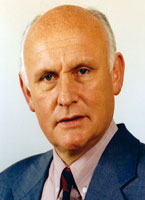
In September 2009, former Labour MEP Michael McGowan called for an urgent independent inquiry led by the United Nations into the Lockerbie disaster. McGowan wrote that he was personally affected by the crash:
- "As President of the Development Committee of the European Parliament, I had invited Bernt Carlsson, the Assistant Secretary-General of the United Nations and UN Commissioner for Namibia, to call in at Brussels in December 1988. He was on his way back to the United States from Namibia and agreed to address members of the Development Committee, which he did. In Brussels, he spoke about his hopes for an independent Namibia and the end of apartheid in South Africa to a packed meeting of MEPs.
- "And afterwards he confirmed his acceptance to visit Leeds the following year to give the 1989 Peace Lecture in honour of Olof Palme, the former Swedish Prime Minister, who was murdered in Stockholm on February 28, 1986. He said how much he was looking forward to coming to Leeds to pay tribute to his fellow Swede with whom he had worked closely as international secretary of the Social Democratic Party of Sweden, and also as a |Palme]]. Bernt Carlsson did not make that visit to Leeds in 1989. He was a passenger on Pan Am Flight 103 and he died when the plane was blown up over Lockerbie on December 21, 1988. He was a giant of diplomacy, gentle, quiet, but a tough negotiator. His death, like that of his friend and fellow Swede, Prime Minister Palme, who was murdered in the street in Stockholm returning with his wife from a night at the cinema, was the result of a terrorist act and remains a mystery.
- "A call by the British Government for an independent inquiry led by the United Nations to find out the truth about Pan Am Flight 103 is urgently required. We owe it to the families of the victims of Lockerbie and the international community to identify those responsible. That Bernt Carlsson was on that plane should be an extra incentive for the UN to take action in view of the fact that this impressive diplomat was dealing with some of the most sensitive and violent situations being perpetrated by the brutal apartheid regime in both South Africa and Namibia, besides his work in the Middle East. The best tribute to the lives and families of the 270 victims of Lockerbie, including Bernt Carlsson, and the most positive action for the international community to take against "terrorism", is to launch an independent inquiry into this gross act of mass murder. Nothing less will suffice."[61]
UN Murder Inquiry
Echoing Michael McGowan's demand for an inquiry, and following publication of his article, a commentator's e-petition in the Yorkshire Post asked prime minister Gordon Brown "to endorse calls for a United Nations Inquiry into the murder of UN Commissioner for Namibia, Bernt Carlsson, in the 1988 Lockerbie bombing." The petition continued:
- "Sweden's UN Commissioner for Namibia, Bernt Carlsson, was the most prominent of the 270 Lockerbie bombing victims murdered on 21 December 1988. In investigating Carlsson's murder, Scottish police detective John Crawford stated in his book ("The Lockerbie Incident: A Detective's Tale"):
- "We even went as far as consulting a very helpful lady librarian in Newcastle who contacted us with information she had on Bernt Carlsson. She provided much of the background on the political moves made by Carlsson on behalf of the United Nations. :"He had survived a previous attack on an aircraft he had been travelling on in Africa.
- "It is unlikely that he was a target as the political scene in Southern Africa was moving inexorably towards its present state....I discounted the theory as being almost totally beyond the realms of feasibility."[62]
The petition concluded:
- "A United Nations Inquiry can be expected to find a different - and much better - explanation for Bernt Carlsson's murder."[63]
United Nations Inquiry
In October 2007, Haseldine had submitted an earlier e-petition to prime minister Gordon Brown:
- "We the undersigned petition the Prime Minister to support calls for a United Nations Inquiry into the death of UN Commissioner for Namibia, Bernt Carlsson, in the 1988 Lockerbie bombing.
- "Dr Hans Koechler, UN observer at the Pan Am Flight 103 bombing trial, has described Mr al-Megrahi's conviction as a 'spectacular miscarriage of justice'. If, as now seems inevitable, the Libyan's conviction is overturned on appeal, Libya will be exonerated and a new investigation is going to be required.
- "Apartheid South Africa is the prime alternative suspect for the Lockerbie Bombing - see South Africa luggage swap theory.
- "We understand that, when Libya takes its seat at the UN Security Council in January 2008, there will be calls for an immediate United Nations Inquiry into the death of UN Commissioner for Namibia, Bernt Carlsson, in the 1988 Lockerbie bombing. The other 14 UNSC members — including Britain — should support such an Inquiry and nominate Dr Koechler to conduct it." [64]
Dual UN Inquiry
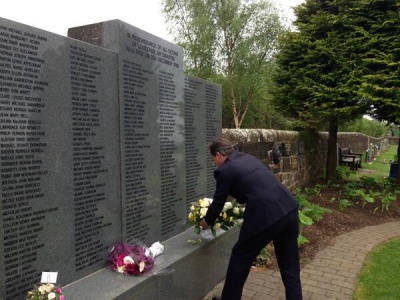
In November 2013, former diplomat Patrick Haseldine created this e-petition calling upon HM Government (Foreign and Commonwealth Office) to:
- "Support a United Nations Inquiry into the deaths of UN Secretary-General Dag Hammarskjöld and UN Assistant Secretary-General Bernt Carlsson"
- On 9 September 2013, the London-based Hammarskjöld Commission reported that there was "significant new evidence" about the plane crash that killed United Nations Secretary-General Dag Hammarskjöld and recommended that the adjourned 1962 UN Inquiry should now be reopened.
- UN Assistant Secretary-General Bernt Carlsson was the highest profile victim on Pan Am Flight 103 which was sabotaged over Lockerbie on 21 December 1988.
- Since Bernt Carlsson's death has never been investigated, the British Government should propose extending the remit of the new UN Inquiry to cover the deaths of both senior diplomats: Dag Hammarskjöld and Bernt Carlsson.
The e-petition was open for signature by UK citizens and residents from 13 November 2013 to 13 May 2014.[65] On 12 December 2013, Lord Kinnock indicated his support for such a Dual UN Inquiry.
On 14 May 2014, Haseldine sent this email to David Cameron via the Prime Minister's Office:
- Dear Prime Minister,
- My e-petition to HM Government had 56 signers when it closed yesterday. That petition requested HMG to "Support a United Nations Inquiry into the deaths of UN Secretary-General Dag Hammarskjöld and UN Assistant Sec-Gen Bernt Carlsson".
- On 13 May 2014, I created four new e-petitions each calling on you to "Open all MI6 files on state sponsored murders":
- 1. http://www.thepetitionsite.com/859/022/615/open-all-mi6-files-on-state-sponsored-murders/
- 2. http://www.change.org/en-GB/petitions/prime-minister-david-cameron-open-all-mi6-files-on-state-sponsored-murders/
- 3. https://you.38degrees.org.uk/petitions/open-all-mi6-files-on-state-sponsored-murders/
- 4. https://secure.avaaz.org/en/petition/Prime_Minister_David_Cameron_Open_all_MI6_files_on_state_sponsored_murders/
- I hope you can agree to open these MI6 files to assist the UN in its reopened investigation.
- Patrick Haseldine
- Emeritus Professor of Lockerbie Studies
Petition to Ban Ki-moon
In April 2014, another e-petition was created and addressed to UN Secretary-General Ban Ki-moon:
- "Take action to investigate the deaths of UN Officials Dag Hammarskjöld and Bernt Carlsson!"[66]
Memorials
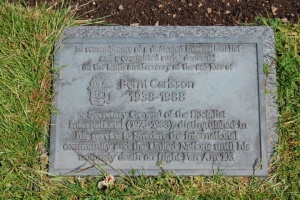
In 2008, to mark the 20th anniversary of the sabotage of Pan Am Flight 103, the Socialist International published an article entitled "Remembering Bernt Carlsson". The article quoted from the eulogy given by Sten Andersson (then Sweden's foreign minister) at the January 1989 memorial service in Stockholm. Andersson described Carlsson as:
- "A man with a natural talent for the difficult art of silent diplomacy. In that art many are unsuccessful. But not Bernt. For Bernt was also a man 'with a soul as tough as steel' as his friend Michael Harrington so nicely put it.
- "We, his friends and colleagues, know that he was knowledgeable, with analytical acumen, single-minded and, most important of all, untiring in his fight for those most exposed, those most persecuted. At all times and in every post Bernt was always prepared in concrete action to make common cause with the weak and oppressed. In our country and the world."[67]
Memorial plaque dedicated to the most prominent of the 270 people killed at Lockerbie on 21 December 1988: Assistant-Secretary-General of the United Nations and UN Commissioner for Namibia, Bernt Carlsson. The inscription reads:
- "In remembrance of a dedicated internationalist and a committed social democrat on the tenth anniversary of the sad loss of Bernt Carlsson (1938-1988), Secretary-General of the Socialist International (1976-1983), distinguished in his service to Sweden, the international community and the United Nations until his untimely death on flight Pan Am 103."[68]
The Bernt Carlsson Trust – otherwise known as One World Action – was founded by Glenys Kinnock on December 21, 1989 (the first anniversary of the Lockerbie air disaster) in memory of Carlsson.[69]
See also
External links
- Countdown to PA 103
- Lost on Flight 103: A Hero to the Wretched of the World
- Namibia's long journey to independence
- Bernt Carlsson Trust
- Socialist International website
Related Documents
| Title | Type | Publication date | Author(s) | Description |
|---|---|---|---|---|
| Document:Afterword to "Who Really Killed Chris Hani?" | Book | 29 February 2024 | Christopher Nicholson | Courts have decided that freedom of expression trumps all other rights as without it nobody, including the courts, would ever hear of breaches of other rights. So those who have attempted to suppress this book have prevented the world from discovering and prosecuting the criminals, who perpetrated the foul murders. In law we would describe them as accessories after the fact of these killings. |
| Document:Justice for Megrahi awaits at the Supreme Court | Letter | 4 April 2021 | Patrick Haseldine | My recommendation, Mr Anwar, is that you appeal to the UK Supreme Court to quash the Scottish Court in the Netherlands' 2001 conviction of Abdelbaset al-Megrahi on the basis of fabricated timer fragment evidence led by the "non-expert witness" Allen Feraday |
| Document:Justice for Megrahi is gonna happen! | Letter | 14 April 2021 | Patrick Haseldine | Aamer Anwar said: "I have no doubt that the new democratic Libyan Government headed by Abdul Hamid al-Dabaiba will support this final appeal for justice on behalf of the Al-Megrahi family and help in our efforts to prove the innocence of Libya and its people." |
| Document:Lockerbie Bombing and my Reinstatement in HM Diplomatic Service | letter | 29 January 1997 | Patrick Haseldine | Former diplomat Patrick Haseldine writes to former Prime Minister James Callaghan |
| Document:Lucky Escapees from Pan Am Flight 103 | Article | 20 October 2018 | Christopher Nicholson | In this article, Judge Nicholson analyses in forensic detail conflicting claims that former foreign minister Pik Botha had been booked to travel on the doomed Pan Am Flight 103 which exploded over Lockerbie, Scotland, on 21 December 1988. The Judge's analysis concludes by asking whether UN Commissioner for Namibia Bernt Carlsson "was not the real target of those who put the bomb on Pan Am 103." |
| Document:Olof Palme - The Man Who Played With Fire | book review | 2020 | Simon Matthews | Bernt Carlsson, a colleague of Olof Palme’s and UN Commissioner for Namibia 1987-1988, died in the Lockerbie bombing on 21 December 1988. Carlsson's presence on Pan Am Flight 103 has been cited as the reason it was bombed. |
| Document:Pan Am Flight 103: It was the Uranium | article | 6 January 2014 | Patrick Haseldine | Following Bernt Carlsson's untimely death in the Lockerbie bombing, the UN Council for Namibia inexplicably dropped the case against Britain's URENCO for illegally importing yellowcake from the Rössing Uranium Mine in Namibia. |
| Document:PanAm-Rätsel LOCKERBIE: Es war Südafrika!…so wie bei Olof Palme | Article | 6 October 1996 | Kurt Seinitz | "It would have been easy for South African secret service agents, who had infiltrated Sweden's anti-apartheid movement, to exchange Carlsson's tape recorder in a hotel room against one containing the bomb. And then placing it inside one of those 'ubiquitous' Samsonite suitcases, so beloved by the peripatetic Bernt Carlsson." |
| Document:Reinstatement in HM Diplomatic Service | Letter | 6 January 1997 | Patrick Haseldine | A plea for reinstatement in the Foreign and Commonwealth Office by "Thatcher's Whitehall Critic" |
| Document:Targeting of Bernt Carlsson on Pan Am Flight 103 | Letter | 17 February 2023 | Patrick Haseldine | Ian Ferguson: "In the early stages of the Lockerbie investigation, Bernt Carlsson's Presikhaaf suitcase was seen as the more likely bomb case. Police sources at the time said that this case was cleared of being the suspect case on November 23rd 1989." |
| Document:The Crime of Lockerbie | Article | 16 August 2009 | Tam Dalyell | Tam Dalyell said: "Yes, I have read 'The Downing Street Years' very carefully. Why in 800 pages did you not mention Lockerbie once?" Mrs Thatcher replied: "Because I didn’t know what happened and I don’t write about things that I don’t know about." |
| Document:The Rossing File:The Inside Story of Britain's Secret Contract for Namibian Uranium | pamphlet | 1980 | Alun Roberts | Scandal in the 1970s and 1980s of collusion by successive British governments with the mining conglomerate Rio Tinto to import yellowcake from the Rössing Uranium Mine in Namibia (illegally occupied by apartheid South Africa) in defiance of international law, and leading to the targeting of UN Commissioner for Namibia Bernt Carlsson on Pan Am Flight 103 in December 1988. |
| Document:UN Wants to Know If Spy Agencies Hold Answer to Dag Hammarskjöld’s Death | Article | 15 July 2017 | Alan Cowell Rick Gladstone | After 56 years and many investigations, there is new hope that secrets lurking in Western intelligence archives could solve "the biggest whodunnit" in United Nations history: the mysterious death of Secretary-General Dag Hammarskjöld... |
| Document:Who Really Killed Chris Hani? | Book | 29 February 2024 | Christopher Nicholson | "Apart from Chris Hani’s murder, we deal with five others, spread over three decades: Patrice Lumumba in September 1961; Dag Hammarskjöld on 18 September 1961; Olof Palme on 28 February 1986; Bernt Carlsson on 21 December 1988; and Anton Lubowski on 12 September 1989." |
References
- ↑ "Dukakis Backers Agree Platform Will Call South Africa 'Terrorist'"
- ↑ "Why doesn't Scotland Yard launch a Bernt Carlsson murder inquiry?"
- ↑ "U.N. Officer on Flight 103" The New York Times December 22, 1988
- ↑ Bernt Carlsson's Obituary, The Guardian December 23, 1988
- ↑ "UN Security Council Resolution 435 of 29 September 1978"
- ↑ "Lost On Flight 103: A Hero To The Wretched Of The World"
- ↑ "Finger of suspicion" The Guardian December 7, 1989
- ↑ "Bernt Carlsson in a secret meeting with 'pressuriser' from the Diamond Cartel"
- ↑ "Lockerbie disaster kept Rössing in business"
- ↑ "Lockerbie Cover-Upper Ian Ferguson"
- ↑ "Lockerbie: Bernt Carlsson's secret meeting in London"
- ↑ "ANC as the fall-guys for Lockerbie bombing" Patrick Haseldine's letter to The Guardian, 22 April 1992
- ↑ "Why the Lockerbie flight booking subterfuge, Mr Botha?"
- ↑ The New York Times 22 January 1989 "Botha suffers mild stroke"
- ↑ "Botha Quits, Criticizes Successor"
- ↑ Robin Oakley, 'Thatcher pursues role as peace broker; Tour of African nations', The Times (27 March 1989)
- ↑ "Cameron's freebie to apartheid South Africa"
- ↑ "Rössing Uranium Mine"
- ↑ "UNSCR 418 of 4 November 1977: States should refrain from 'any co-operation with South Africa in the manufacture and development of nuclear weapons'"
- ↑ "South Africa: Missile"
- ↑ "The US and UK lost three nuclear weapons each! Part 2 - What went missing on Prime Minister Thatcher’s Watch?"
- ↑ "The US and UK lost three nuclear weapons each! Part 3 - What went missing on Prime Minister Thatcher’s Watch?"
- ↑ "The US and UK lost three nuclear weapons each! Part 4 - What went missing on Prime Minister Thatcher’s Watch?"
- ↑ "UK’s Electoral Commission to investigate Friends of Israel Groups"
- ↑ "Missing diplomatic links and the Lockerbie tragedy"
- ↑ "Destroying Libya and World Order: The Three-Decade U.S. Campaign to Terminate the Gaddafi Revolution"
- ↑ Dukakis Backers Agree Platform Will Call South Africa 'Terrorist'
- ↑ "Lockerbie: CIA 'fitted up' Gaddafi at the UN"
- ↑ "Tiny Rowland, Lonmin and Lockerbie
- ↑ "Blackout of Mandela Blueprint for Lockerbie Justice"
- ↑ "Commentary on The Maltese Double Cross"
- ↑ "Cover-up of Convenience"
- ↑ "Megrahi: You are my Jury"
- ↑ "Was Libya really behind it?"
- ↑ "Scotland’s Shame: Why Lockerbie Still Matters"
- ↑ "Lockerbie Revisited"
- ↑ "Lockerbie Cover-Upper Ian Ferguson"
- ↑ "Robert Forrester Facebook page"
- ↑ "Former MI6 spy joins Armor Group to hunt down new business"
- ↑ "Alan George libel case
- ↑ "Dr Morag Kerr should drop all this cloak and dagger 'Rolfe' nonsense"
- ↑ "Adequately Explained by Stupidity? Lockerbie, Luggage and Lies"
- ↑ "The Lockerbie Divide"
- ↑ "Blackout over Lockerbie"
- ↑ "Never at a Loss for Words"
- ↑ "Bernt Carlsson: A Very Private Public Servant" Robin V. Sears (1989) Development Dialogue (Dag Hammarskjöld Foundation) pages 82–88
- ↑ Christopher Hitchens, "For the sake of Argument: Essays and Minority Reports", Verso (1993) ISBN 0-86-091435-6
- ↑ "One view from a desolate hillside"
- ↑ "Namibia's independence process 1988-1990"
- ↑ "Bernt Carlsson: Assassinated on Pan Am Flight 103"
- ↑ "Feraday's Evidence - The Final Day"
- ↑ "Follow The Yellowcake Road"
- ↑ World In Action "Follow The Yellowcake Road"
- ↑ "Council for Namibia sues Netherlands over Namibia's natural resources"
- ↑ "De Beers face prosecution"
- ↑ "Bernt Carlsson and the Case of the Disappearing Diamonds"
- ↑ "Murder of Bernt Carlsson must not go unpunished"
- ↑ "Flight 103: It was the Uranium"
- ↑ "Read Patrick Haseldine´s thoughts on the Lockerbie bombing trial."
- ↑ "Pan Am 103/Lockerbie website"
- ↑ "Michael McGowan: The best tribute to the 270 victims of Lockerbie is to find out the truth"
- ↑ "The Lockerbie Incident: A Detective's Tale" John Crawford (2002), pages 88-89
- ↑ "Petition to PM Gordon Brown for a United Nations Inquiry into Bernt Carlsson's murder"
- ↑ "UN Inquiry into the death of UN Commissioner for Namibia, Bernt Carlsson, in the 1988 Lockerbie bombing"
- ↑ "E-petition to HM Government"
- ↑ "Take action to investigate the deaths of UN Officials Dag Hammarskjöld and Bernt Carlsson!
- ↑ "Remembering Bernt Carlsson"
- ↑ Photo by George DeBaly, June 2009, in the Garden of Remembrance at the Lockerbie Air Disaster Memorial in Dryfesdale Cemetery.
- ↑ "One World Action"
Wikipedia is not affiliated with Wikispooks. Original page source here
